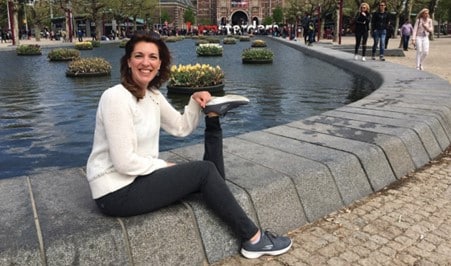By Allison Miller
“When will I be able to travel again?”
 This was the question I was desperate to ask but afraid to have answered during my first meeting with a prosthetist in 2014. I had been in the hospital for more than two months after suffering an acute illness, sepsis, and having my left leg amputated above the knee. I wasn’t even sure of my hospital discharge date yet, but I wanted to know how long it would take to check in for a flight once I checked out of the hospital.
This was the question I was desperate to ask but afraid to have answered during my first meeting with a prosthetist in 2014. I had been in the hospital for more than two months after suffering an acute illness, sepsis, and having my left leg amputated above the knee. I wasn’t even sure of my hospital discharge date yet, but I wanted to know how long it would take to check in for a flight once I checked out of the hospital.
My wanderlust started young. As a kid, I would fill out every promotional mailer inside travel magazines and eagerly await the glossy brochures in return. My prize brochure — thick as a book — was for Australia! I kept all my travel treasures in a dresser drawer and would periodically pull out the brochures and contemplate what it would be like to visit these far places.
As an adult, I was lucky enough to visit many of these dresser drawer destinations, including Australia, South Africa, Brazil, and right before my illness, even Tahiti. But I’d taken those trips with two legs — a key detail — and now I was worried my travel days were over or, at minimum, would be vastly different.
I eagerly asked how long it would be before I could confidently walk a city street or stroll a white sand beach and time and again there was no answer. In hindsight, I understand why. So much about becoming an amputee is specific to the individual — your overall health, age, device, and your access to a good physical therapist — that it is almost impossible to give a timeline. This ambiguousness would become one of the most frustrating things about being an amputee and pervaded everything, including my attempts to research resources for disabled travelers.
Once out of the hospital, I started planning my first one-leg trip, but how would I do it? As a well-seasoned traveler, I craved detailed information that went beyond the basics of TSA screening and the obvious travel generalities. I wanted to know about the experience of traveling with one leg and the practical tips for adapting travel to my new reality.
I never did find a solid source for this kind of information and instead just embarked on one trip after another learning lessons on the ground, in the air, and even underwater. I learned how to time placing my foot and my suitcase on a quick-moving escalator, how to pick an optimal airline seat, and even how to improvise a shower chair when necessary. But mostly I just learned how to adapt and persevere.
Now, eight years into this one-legged life, I’m planning what might be my most ambitious trip yet — a visit to Chile’s Lake District.
On the northern edge of Patagonia, the Lake District is filled with stunning vistas, waterfalls, volcanoes, mountains, and lots of national parks. The hikes are limitless, even if the accessibility is not. But I’m up for a challenge and am starting the work of researching trails and taking practice hikes closer to home. Climbing a volcanic peak is not so much my goal, but rather reaching the peak of my own ability and adaptability.
I no longer have two legs, nor do I have a drawer filled with travel brochures, but I still have the same desire to experience the world and want to help others do the same. Being an amputee doesn’t mean your world has to shrink, you just have to find new ways in which to explore it.

